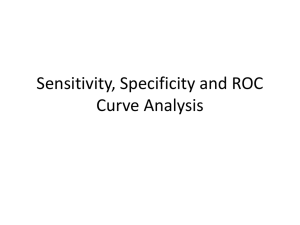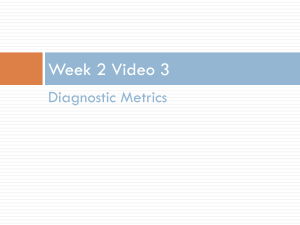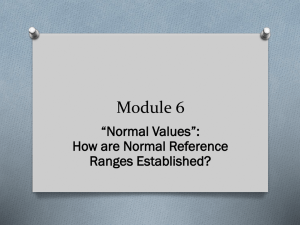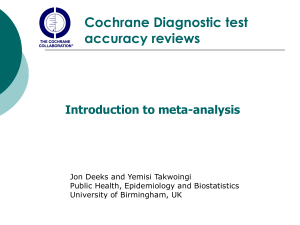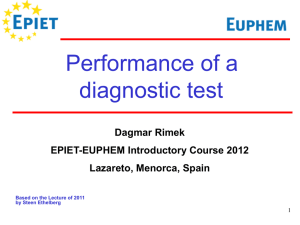Sensitivity & specificity
advertisement
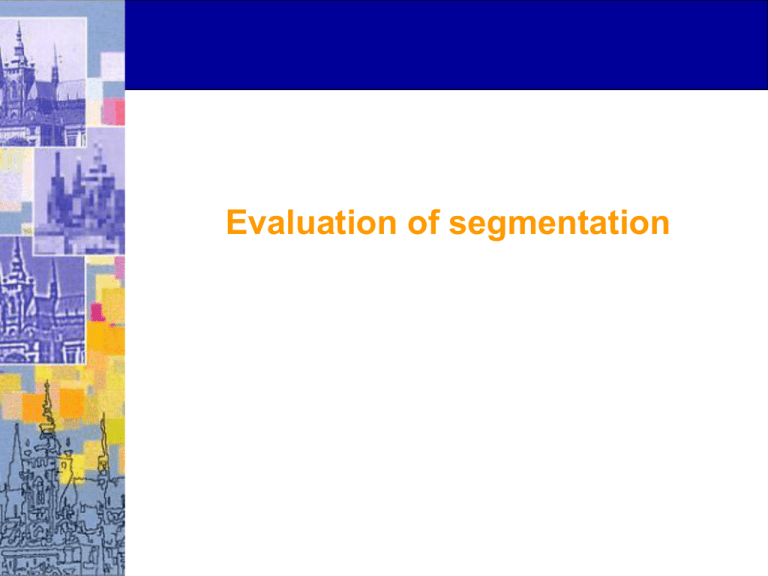
Evaluation of segmentation Example Reference standard & segmentation Segmentation performance • Qualitative/subjective evaluation the easy way out, sometimes the only option • Quantitative evaluation preferable in general • A wild variety of performance measures exists • Many measures are applicable outside the segmentation domain as well • Focus here is on two class problems Some terms • • • • Ground truth = the real thing Gold standard = the best we can get Bronze standard = gold standard with limitations Reference standard = preferred term for gold standard in the medical community What to evaluate? • Without reference standard, subjective or qualitative evaluation is hard to avoid • Region/pixel based comparisons • Border/surface comparisons • (a selection of) Points • Global performance measures versus local measures Example Reference standard & segmentation What region to evaluate over? Combination of reference and result masked true positive true negative false negative false positive False positives False negatives Confusion matrix (Contingency table) Segmentation negative negative positive 191152 3813 TN Reference positive 9764 FP 19648 FN TP Do not get confused! • False positives are actually negative • False negatives are actually positives Confusion matrix (Contingency table) Segmentation negative negative positive .852 .017 TN FP Reference positive .044 .088 FN TP Accuracy, sensitivity, specificity sensitivity = true positive fraction = 1 – false negative fraction = TP / (TP + FN) specificity = true negative fraction = 1 – false positive fraction = TN / (TN + FP) accuracy = (TP + TN) / (TP + TN + FP + FN) Accuracy • Range: from 0 to 1 • Useful measure, but: • Depends on prior probability (prevalence); in other words: on amount of background • Even ‘stupid’ methods can achieve high accuracy (e.g. ‘all background’, or ‘most likely class’ systems) Sensitivity & specificity • Are intertwined • ‘stupid’ methods can achieve arbitrarily large sensitivity/specificity at the expense of low specificity/sensitivity • Do not depend on prior probability • Are useful when false positives and false negatives have different consequences P N N P P P N N P N N P P P N N true positives (TP) false positives (FP) sensitivity = true positive fraction = 1 – false negative fraction false negatives (FN) = TP / (TP + FN) true negatives (TN) specificity = true negative fraction = 1 – false positive fraction = TN / (TN + FP) accuracy = (TP+TN) / (TP+TN+FP+FN) P N N P P P N N P N N P P P N N true positives (TP) = 3 false positives (FP) = 3 sensitivity = TP / (TP + FN) = 3 / 5 = 0.6 false negatives (FN) = 2 true negatives (TN) = 4 specificity = TN / (TN + FP) = 4 / 7 = 0.57 accuracy = (TP+TN) / (TP+TN+FP+FN) = 7 / 12 = 0.58 P P P N P N N N P P N P P P N algorithm 1 =3 algorithm 2 P P =4 =3 =5 P N P P P P N N N =2 N N =1 =4 =2 P P N P sensitivity = 3 / 5 = 0.6 specificity = 4 / 7 = 0.57 accuracy = 7 / 12 = 0.58 sensitivity = 4 / 5 = 0.8 specificity = 2 / 7 = 0.29 accuracy = 6 / 12 = 0.5 Which system is better? Back to the retinal image… result reference negative positive negative .852 TN .017 FP positive .044 FN .088 TP Accuracy: 0.93949 Sensitivity: 0.668027 Specifity: 0.980443 Overlap = intersection / union = TP/(TP+FP+FN) Reference FN Segmentation TP TN FP Overlap • Overlap ranges from 0 (no overlap) to 1 (complete overlap) • The background (TN) is disregarded in the overlap measure • Small objects with irregular borders have lower overlap values than big compact objects Kappa • Accuracy would not be zero if we used a system that is ‘guessing’ • A ‘guessing’ system should get a ‘zero’ mark (remember multiple choice exams…) • Kappa is an attempt to measure ‘accuracy in excess of accuracy expected by chance’ Kappa Result negative positive Reference negative 191152 positive 3813 194965 9764 19648 29412 200916 23461 224377 System positive rate: 23461/224377 = .105 System accuracy: (191152 + 19648)/ 224377 = .939 Total number of positives True positives of a guessing system: .105 * 29412 = 3075 … etc Accuracy guessing system: .792 Kappa • accguess = the accuracy of a randomly guessing system with a given positive (or negative) rate • kappa = (acc – accguess) / (1 – accguess) • In our case: kappa = (.939 - .792)/(1 - .792) = .707 Kappa • Maximum value is 1, can be negative • A ‘guessing’ system has kappa = 0 • ‘Stupid systems’ (‘all background’ or ‘most likely class’) have kappa = 0 • Systems with negative kappa have ‘worse than chance’ performance Positive/negative predictive value • PPV and NPV depend on prevalence, contrary to sensitivity and specificity ROC analysis Evaluating algorithms • Most algorithms can produce a continuous instead of a discrete output, monotonically related to the probability that a case is positive. • Using a variable threshold on such a continuous output, a user can choose the (sensitivity, specificity) of the system. This is formalized in an ROC (receiver operator characteristic) analysis. Reference standard & segmentation Reference standard & soft segmentation ROC analysis Pn(x) Pp(x) true positive fraction true negative fraction false positive fraction x ROC curve 1 0.8 true positive probability true positive fraction sensitivity detection rate 0.9 0.7 0.6 0.5 0.4 0.3 0.2 0.1 0 0 0.1 0.2 0.3 0.4 0.5 0.6 0.7 0.8 false positive probability false positive fraction 1 - specificity chance of false alarm 0.9 1 ROC curves • • • • • Receiver Operating Characteristic curve Originally proposed in radar detection theory Formalizes the trade-off between sensitivity and specificity Makes the discriminability and decision bias explicit Each hard classification is one operating point on the ROC curve ROC curves • A single measure for the performance of a system is the area under the ROC curve Az • A system that randomly generates a label with probability p has an ROC curve that is a straight line from (0,0) to (1,1), Az = 0.5 • A perfect system has Az = 1 • Az does not depend on prior probabilities (prevalence) ROC curves • If one assumes Pn(x) and Pp(x) are Gaussian, two parameters determine the curve: the difference between the means and the ratio of the standards deviations. They can be estimated with a maximum-likelihood procedure. • There are procedures to obtain confidence intervals for ROC curves and to test if the Az value of two curves are significantly different. Intuitive meaning for Az • Is there an intuitive meaning for Az? • Consider the two-alternative forced-choice experiment: an observer is confronted with one positive and one negative case, both randomly chosen. The observer must select the positive case. What is the chance that the observer does this correctly? Pp(x) Pn(x) x x chancecorrectdecision 2 - AFC exp. dx Pn( x) dx' Pp ( x' ) 1 0.9 true positive probability 0.8 Az 0.7 0.6 0.5 dx P ( x) dx' P ( x' ) n 0.4 p x 0.3 0.2 true positive fraction 0.1 0 0 0.1 0.2 0.3 0.4 0.5 0.6 0.7 false positive probability 0.8 0.9 1 width false positive fraction column Az as a segmentation performance measure • Ranges from 0.5 to 1 • Soft labeling is required (not easy for humans in segmentation) • Independent of system threshold (operating point) and prevalence (priors) • Depends on ‘amount of background’ though! Summary • Various pixel-based measures were considered for two class, hard (binary) classification results: – Accuracy – Sensitivity, specificity – Overlap – Kappa • ROC

